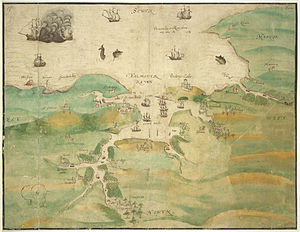3rd Spanish Armada
| 3rd Spanish Armada | |||||||
|---|---|---|---|---|---|---|---|
| Part of the Anglo-Spanish War | |||||||
 Falmouth at the time of invasion |
|||||||
|
|||||||
| Belligerents | |||||||
|
|
|
||||||
| Commanders and leaders | |||||||
|
|
|
||||||
| Strength | |||||||
|
Fleet: 44 galleons 16 merchant galleons 52 hulks 24 small craft Troops 9,634 soldiers 4,000 sailors Total: 140 ships 13,000- 14,000 men |
Fleet: 12 ships rising to 120 ships (23rd October) Troops: 500 (October) rising to 8,000 (November) |
||||||
| Casualties and losses | |||||||
| 6 ships captured, 400 captured Storms 22 ships sunk or destroyed 1,000 dead Total: 28 ships, 1,500 killed or captured |
1 bark sunk Low |
||||||
Spanish failure
The 3rd Spanish Armada also known as the Spanish Armada of 1597 was a major naval event that took place between October and November 1597 as part of the Anglo–Spanish War. The armada, which was the third attempt by Spain to invade or raid the British Isles during the war, was ordered by King Philip II of Spain in revenge for the English attack on Cadiz following the failure of the 2nd Spanish Armada months before due to a storm. The Armada was executed by the Adelantado; Martín de Padilla who was hoping to intercept and destroy the returning English fleet under Robert Devereux the 2nd Earl of Essex from the failed Azores expedition. When this was achieved the armada would go on to capture either the important port of Falmouth or Milford Haven and use those places as a base for invasion.
When the Spanish arrived in the English channel however they were dispersed by a storm which scattered their fleet. As a result, some ships did push on, and troops were even landed on the English and Welsh coasts. The English fleet, which had also been scattered by the same storm, were unaware that the Spanish had come to intercept them. The English fleet arrived safely in England with loss of only one ship. As a result, Padilla finally ordered a retreat back to Spain. A number of Spanish ships were captured in action by returning English ships from which valuable information was given about the Armada. Panic in England then ensued partly because the English fleet had been out to sea with the English coast virtually undefended. This caused the relationship between Queen Elizabeth I of England and the Earl of Essex to deteriorate further and instead Charles Howard, the 1st Earl of Nottingham took charge of and immediately sent the English fleet out to hunt the Spanish, most of whom had arrived back at port. Any remaining Spanish ships were rounded up and captured along with their soldiers and crew. Philip took much of the blame for the failure by the Armada commanders particularly Padilla. The Armada was the last of its kind that the Spanish would execute under Philip II before his death.
...
Wikipedia
